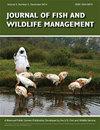利用鳍条和鳍刺估算佛罗里达鲈鱼的非致死年龄
IF 0.9
4区 环境科学与生态学
Q4 BIODIVERSITY CONSERVATION
引用次数: 0
摘要
利用鳍条和鳍刺对佛罗里达鲈鱼(Micropterus salmoides)进行非致命性年龄估计的方法将加强对鲈鱼的研究、管理和保护。非致命性切除鳍结构还将扩大收集年龄相关信息的机会,特别是在小种群项目以及锦标赛和公民科学项目中,因为牺牲鱼类是不可取的。我们评估了从佛罗里达鲈鱼臀鳍、盆鳍、背鳍和胸鳍鳍条以及臀鳍、盆鳍和背鳍棘得出的年龄估计值的偏差,并将其与从耳石(即矢状鳍)得出的年龄估计值进行比较,耳石是佛罗里达鲈鱼年龄估计的标准。我们通过计算每个读者的每个年龄结构的重复读数之间的绝对差值来评估年龄估计的精确度。线性混合效应模型选择表明,年龄、结构和年龄*结构交互作用对精确度的影响最大,其中年龄的影响因结构而异。在所有检测结构中,耳石估算的年龄最为精确,而盆骨刺估算的年龄最不精确。所有鳍结构的偏差相似,但年龄对偏差的影响因阅读器而异。边际增量分析表明,佛罗里达鲈鱼背鳍棘刺的环面形成在 11 月至 3 月间完成,比佛罗里达鲈鱼耳石早 5 个月。我们的研究结果表明,非致死性切除的鳍结构(尤其是背鳍刺)有可能用于估计鲈鱼种群的年龄、生长率、死亡率和年龄结构,这在鲈鱼能达到非同寻常的战利品大小的地方尤其有益。本文章由计算机程序翻译,如有差异,请以英文原文为准。
Use of Fin Rays and Fin Spines in Nonlethal Age Estimation of Florida Bass
Nonlethal age-estimation methods for Florida Bass Micropterus salmoides using fin rays and spines would enhance trophy-bass research, management, and conservation. Nonlethal removal of fin structures would also expand opportunities for collecting age-related information, specifically during small-population projects as well as tournaments and citizen-science programs, for which sacrificing fish is not an option. We assessed the bias of age estimates derived from Florida Bass anal-, pelvic-, dorsal-, and pectoral-fin rays and anal-, pelvic-, and dorsal-fin spines by comparing them to age estimates derived from otoliths (i.e., sagittae), which are the standard for ageing Florida Bass. We evaluated the precision of age estimates by calculating the absolute difference between replicate reads of each ageing structure for each reader. Linear-mixed effects model selection indicated that precision was most affected by age, structure, and the age*structure interaction, in which the effect of age varied by structure. Age estimates from otoliths were the most precise whereas pelvic spines were the least precise among all structures examined. Bias was similar across all fin structures, but the effect of age on bias varied by reader. Marginal increment analysis indicated that annulus formation was completed from November to March in Florida Bass dorsal spines, 5 months earlier than in Florida Bass otoliths. Our results suggest that nonlethally removed fin structures, especially dorsal spines, have potential for use in estimating age, growth rates, mortality, and age structure of bass populations, which could be particularly beneficial where bass can reach unusual trophy sizes.
求助全文
通过发布文献求助,成功后即可免费获取论文全文。
去求助
来源期刊

Journal of Fish and Wildlife Management
BIODIVERSITY CONSERVATION-ECOLOGY
CiteScore
1.60
自引率
0.00%
发文量
43
审稿时长
>12 weeks
期刊介绍:
Journal of Fish and Wildlife Management encourages submission of original, high quality, English-language scientific papers on the practical application and integration of science to conservation and management of native North American fish, wildlife, plants and their habitats in the following categories: Articles, Notes, Surveys and Issues and Perspectives. Papers that do not relate directly to native North American fish, wildlife plants or their habitats may be considered if they highlight species that are closely related to, or conservation issues that are germane to, those in North America.
 求助内容:
求助内容: 应助结果提醒方式:
应助结果提醒方式:


